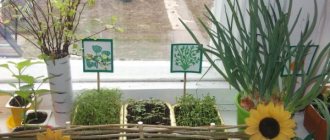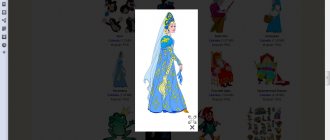MAGAZINE Preschooler.RF
A project in the second junior group to develop a culture of health “Healthy Baby!”Prepared by: teacher Gulyaeva E. A. Pochinki 2022 MUNICIPAL STATE PRE-SCHOOL EDUCATIONAL INSTITUTION POCHINKOVSKY KINDERGARTEN No. 8
Type of project: informational and creative.
Project type: educational and gaming.
Implementation timeframe: short-term.
Project participants: teacher, children of the second junior group and their parents.
PROBLEM.
There is a significant increase in the number of morbidity cases, which requires the use of modern, innovative approaches to educational and health work.
Children are not familiar with the concept of “healthy lifestyle” ; they do not realize the importance of health and how to maintain and strengthen it. To the teacher’s question: “What should you do to avoid getting sick?”
Children answer:
- You need to take medicine or pills.
The educational field of health requires us to form healthy lifestyle habits in children, which always come first.
In the process of everyday work with children, it is necessary to strive to ensure that following the rules of personal hygiene becomes natural for them, and that hygiene skills are constantly improved with age.
Goal: developing a culture of health in children 3-4 years old; maintaining and strengthening children's health; introducing children and their parents to a healthy lifestyle.
Tasks:
Educational:
- Give an idea of a healthy lifestyle.
- Continue to introduce the rules of personal hygiene.
- Promote the health of children through a system of health-improving activities.
Educational:
- Develop cultural and hygienic skills in children.
- Reinforce ideas about the rules of personal hygiene; clarify and systematize children’s knowledge about the need for hygiene procedures.
- To develop in children the ability to perform correct breathing exercises and exercises.
Educational:
- To foster children's interest in a healthy lifestyle.
- To instill in children a desire to engage in physical education, sports, to harden themselves, to take care of their health, and to treat their bodies with care.
- To instill in children a desire to look clean, neat and tidy.
- Strengthen the connections between the kindergarten and the family, change the position of parents regarding their health and the health of their children.
Expected results:
- Preserving and strengthening the health of children through a system of comprehensive physical education and health work.
- Improving children's independence skills while observing cultural and hygienic procedures.
- Formation of desire and desire to lead a healthy lifestyle.
- Children and parents have a basic understanding of the value of health.
Implementation stages:
Stage 1 - organizational:
Collecting information and preparing literature on the topic of the project, planning, involving parents in the implementation of the project.
Stage 2 – cognitive – research:
Conducting thematic classes, conversations, experiments, recreational activities.
Stage 3 – practical:
Learning: breathing exercises, exercises, nursery rhymes, poems, finger games, proverbs. Modeling.
Stage 4 - final:
Conducting an integrated lesson “Journey to the Land of Health” , parent meeting on the topic: “Healthy family lifestyle” , presentation of the project.
Forms and methods of implementation:
Shapes:
- Observations;
- Conversations;
- Situational conversation;
- Classes;
- Reading fiction and educational literature;
- Examination of photographs and illustrations;
- Outdoor and musical games;
- Gymnastics (morning, breathing, after sleep);
- Consultations (for parents).
Methods:
- Verbal:
Conversation, reading fiction, poems, teacher's stories, nursery rhymes, proverbs, riddles.
- Visual:
Examination of photographs and illustrations, paintings, books, teacher showing exercises, gymnastics.
- Practical:
Productive activities, recreational activities, musical activities, experiments.
- Gaming:
Didactic games, outdoor games, finger games, role-playing games.
NODE SUBJECTS:
CONVERSATIONS:
- How will I take care of my health?
- Cleanliness is the key to health.
- Sleep is health.
- How to protect yourself from illness.
- How will I harden myself?
- About healthy food.
- Useful - not useful.
- Who are microbes and where do they live?
- Sun, air and water are my best friends.
READING:
- K. Chukovsky “Doctor Aibolit” , “Moidodyr” , “Fedorino’s grief” .
- S. Mikhalkov “About a girl who ate poorly .
- I. Demyanova “Zamarashka” .
- Poem: “What does it mean to be clean?” , “Me and the sun” .
- Nursery rhymes: “Water, water...” , “Open the faucet! Nose, wash your face!” , “Water, water makes everything sparkle with smiles!” .
- A. Barto “Dirty Girl” , “Girly Girl” .
INTEGRATED CLASSES:
- “Animals and favorite toys got sick”.
- "Journey to the Land of Health".
EXPERIMENTS:
- With sand “Which sand is dirty or clean” , “Which sand is better to play with: wet, dry?” .
- How water and soap help us fight germs.
ARTISTICALLY PRODUCTIVE:
- Stencil drawing of vegetables and fruits (pencils, felt-tip pens).
- Modeling "Microbes on hands" .
GAME:
- The plot game “Katya the doll meets and treats guests with delicious and healthy dishes .
- Story game “The bear is sick, let’s treat him .
MUSICAL:
- Musical and rhythmic movements: “Legs and Legs”
(V. Agafonnikov).
- Song “The gray bunny washes himself” (M. Krasev).
- Exercise “Horse” (music by Tchaikovsky)
- Gymnastics “Nodding our heads.” .
- Massage “The mice came out one day to see what time it was...” .
WORKING WITH PARENTS:
- Folder moving “Healthy family lifestyle” .
- Consultation “Nurture cultural and hygienic skills in children .
- Consultation “Healthy lifestyle” .
- “Family Health Day for Adults and Children” - a recommendation for spending the weekend.
- Consultation . ”
- Card index “Breathing exercises in kindergarten” .
- Game exercises for the development of physiological and speech breathing.
- Consultation “Gymnastics – a means for quick recovery .
- Physical education “How the bear became healthy .
- Compilation of the album – “A healthy mind in a healthy body” .
- Making sports items for children to develop health savings.
RESULT: Educational value: Children have significantly increased their interest and desire to do gymnastics, physical education, and take part in hardening procedures.
Cognitive value: Children have increased knowledge about the importance of a healthy lifestyle. The idea of hardening activities has expanded.
Perspective: In order to increase interest in a healthy lifestyle, it is necessary to continue systematic work in this direction through the creation and implementation of new joint projects, and the use of an integrated approach in this direction.
Bibliography:
- Teplyuk S.N. Walking activities with kids. Ed. Mosaic-Sintez, Moscow 2010
- Penzulaeva L. I. Health-improving gymnastics for children 3-7 years old. Ed. Mosaic-Sintez, Moscow 2010
- Savelyeva N.V. Organization of health-improving work in preschool educational institutions. Rostov-on-Don, Phoenix, 2005
- Morgunova O. N. Physical education and health work in preschool educational institutions. Practical guide. Voronezh, 2007
- Improvement of children's health in a kindergarten. Edited by L. V. Kochetkova. M., 2007
- Gubanova N. F. Development of gaming activities in the 2nd junior group. Mosaic - Synthesis, M., 2009
- Gerbova V.V., Ilchuk N.P. A book for reading in kindergarten and at home. Ed. "Onyx" , Moscow 2009
| Next > |

